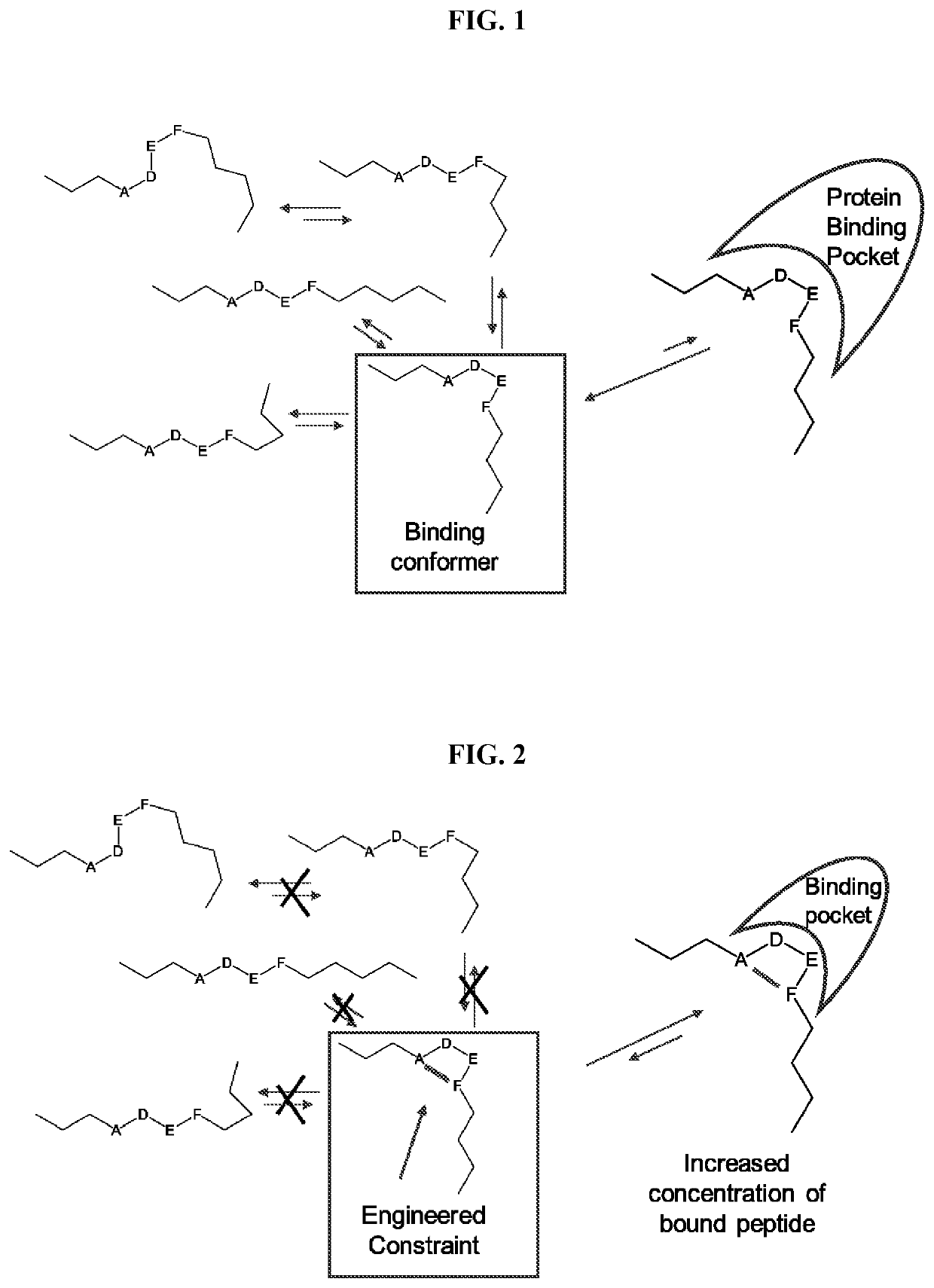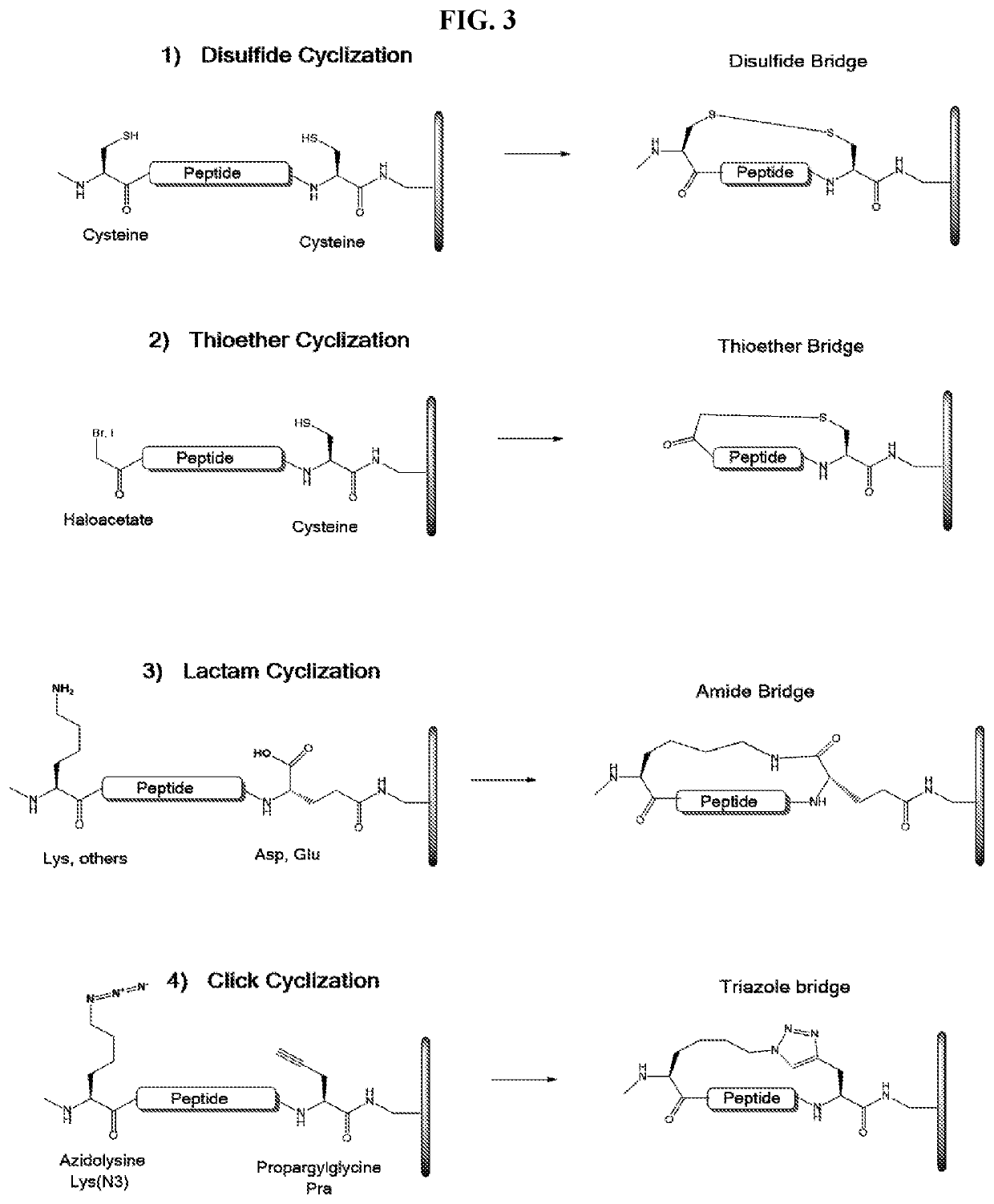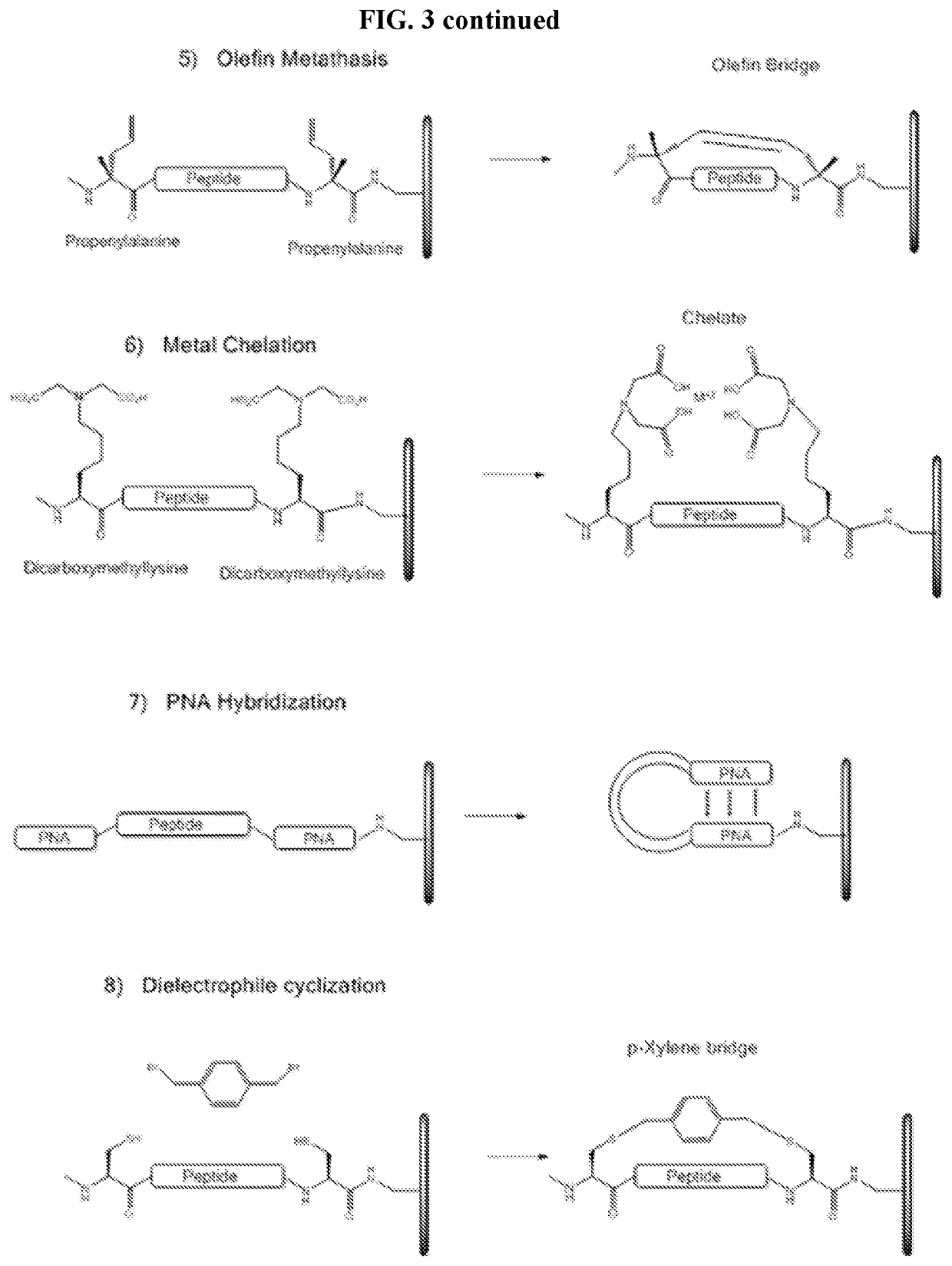Array-based cyclic peptide libraries
a cyclic peptide and library technology, applied in the field of array-based cyclic peptide libraries, can solve the problems of not providing sufficient three-dimensional structure required for efficiently detecting protein-peptide or peptide-peptide interactions, and achieve the effects of reducing or eliminating non-binding conformational structures, increasing the concentration of binding conformational structures available, and increasing the binding of binding
- Summary
- Abstract
- Description
- Claims
- Application Information
AI Technical Summary
Benefits of technology
Problems solved by technology
Method used
Image
Examples
example 1
on of Silicon Oxide Surface for Peptide Array Synthesis
[0418]A 200 mm diameter silicon wafer with SiO2 surface was functionalized in a multi-step process to generate the polyfunctional linker shown in FIG. 17. Briefly, the SiO2 surface was cleaned by immersion in concentrated H2SO4 / H2SO5 (Nano-Strip 2X®) at 85° C. for 30 min, and then rinsed with water and spin dried. The wafer was functionalized by treatment with 90.5 mM 3-glycidoxypropyltrimethoxysilane (GPTMS) in mesitylene at 70° C. for 95 min. The wafer was rinsed with IPA and spin dried. The epoxides were extended by vapor phase deposition of 2,2′-(ethylenedioxy)bis(ethylamine) (EDBA) in a commercial chemical vapor deposition system at 100° C. for 30 min. Reactive amines were treated with a 0.1 M solution of Boc-Gly-OH, 0.1 M HATU, 0.2 M DIEA for 30 min. Unreactive surface amines were capped by treatment with acetic anhydride in THF. The Boc group was removed by treatment of the wafer with TFA or another suitable acid followed...
example 2
of Carbobenzyloxy (Cbz) Protected Diketopiperazine Linker on Functionalized Silicon Oxide Surface
[0421]A 200 mm SiO2 wafer with Boc-PEG6-Gly-EDBA-GPTMS surface prepared in Example 1 was subjected to a ‘dicing’ process that created SiO2 wafer fragments of convenient dimensions, for example 20×25 mm. The fragments were placed facing upwards in glass Petri dishes (100×15 mm) and subjected to standard Boc-based solid phase peptide synthesis steps at room temperature.
[0422]Step 1) The N-terminal Boc group was removed by immersion in 12 mL of neat TFA for 10 min with gentle swirling. The TFA was decanted and the fragments washed with NMP, 5% DIEA in NMP, IPA, then dried under stream of nitrogen.
[0423]Step 2) A freshly prepared NMP solution of Fmoc-proline glycolic acid ester (Fmoc-Pro-O-Glyc-OH, CAS #131228-94-9), HATU, and DIEA (0.1, 0.1, 0.2 M respectively) was added to the fragment, which was swirled gently for 15 min. The solution was decanted and fragment washed with NMP (3×).
[0424]S...
example 3
of Boc Protected Diketopiperazine Linker on Functionalized Silicon Oxide Surface
[0426]The procedure in Example 2 was followed except that Boc-Lys(Fmoc)-OH (CAS #115186-31-7) was used in Step 4 to provide the Boc-Lys(Fmoc)-Pro-O-Glyc-PEG6-Gly-EDBA-GPTMS-SiO2 surface.
Example 4: Fmoc-Based Synthesis of Click Cyclization Peptide TMPP-Lys(N3)-Phe-Pro-Gly-Leu-Pra-Leu-(Boc-Lys-Pro-O-Glyc)-PEG6-Gly-EDBA-GPTMS-SiO2
[0427]Silicon oxide wafer fragments functionalized with the Boc protected DKP linker from Example 3 were used. A 0.20 M NMP stock solution of HATU and 0.2 M NMP stock solutions of following Nα-Fmoc protected amino acids were prepared: Fmoc-6-azido-L-norleucine (Fmoc-Lys(N3)-OH, CAS #159610-89-6), Fmoc-Phe-OH, Fmoc-Pro-OH, Fmoc-Gly-OH, Fmoc-Leu-OH, and Fmoc-propargylglycine (Fmoc-Pra-OH, CAS #198561-07-8).
[0428]The peptide was assembled stepwise by repetitive Fmoc deprotections with 20% piperidine / NMP for 10 min followed by washing with NMP (4×), then coupling of freshly prepared s...
PUM
| Property | Measurement | Unit |
|---|---|---|
| Fraction | aaaaa | aaaaa |
| Fraction | aaaaa | aaaaa |
| Fraction | aaaaa | aaaaa |
Abstract
Description
Claims
Application Information
 Login to View More
Login to View More - R&D
- Intellectual Property
- Life Sciences
- Materials
- Tech Scout
- Unparalleled Data Quality
- Higher Quality Content
- 60% Fewer Hallucinations
Browse by: Latest US Patents, China's latest patents, Technical Efficacy Thesaurus, Application Domain, Technology Topic, Popular Technical Reports.
© 2025 PatSnap. All rights reserved.Legal|Privacy policy|Modern Slavery Act Transparency Statement|Sitemap|About US| Contact US: help@patsnap.com



